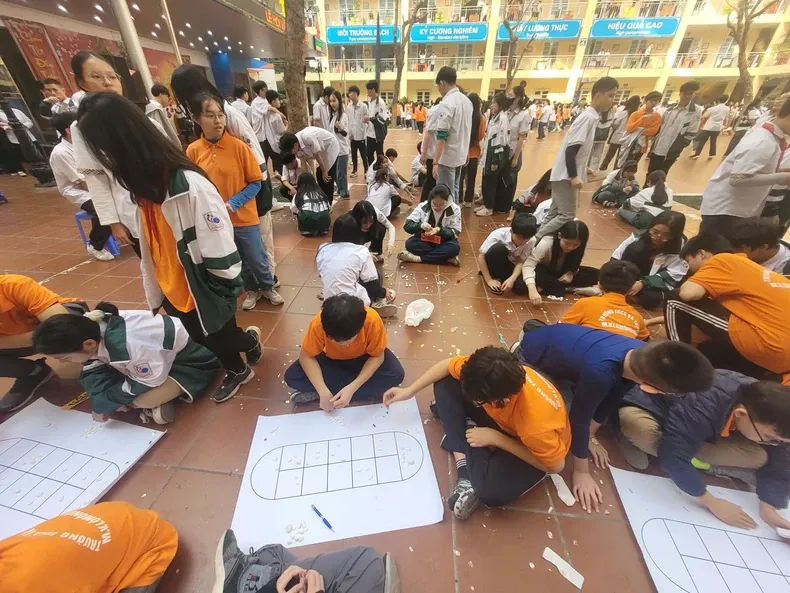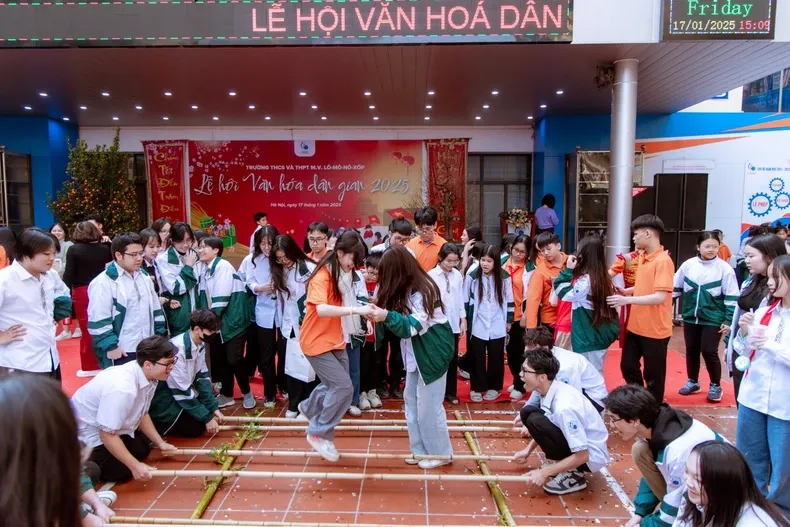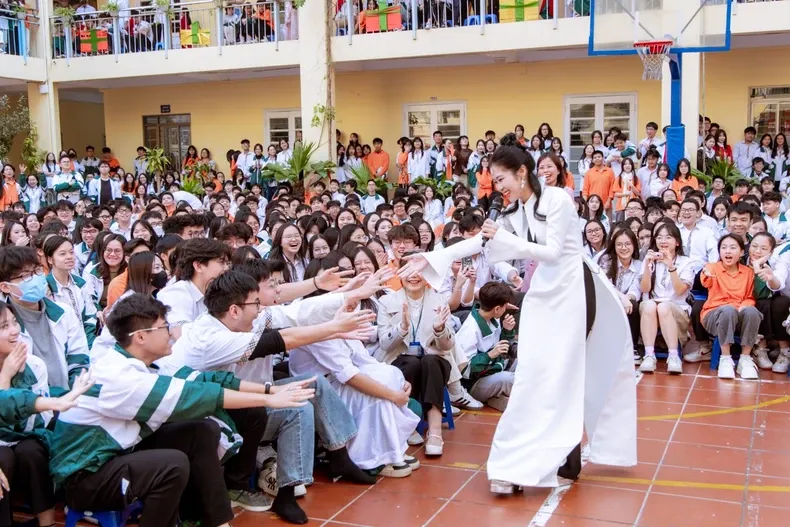Folk culture festivals offer students a valuable opportunity to learn about and explore the beautiful traditional values of the nation. These activities not only help them deeply understand history and culture but also nurture love for their homeland. So, what makes Vietnamese folk culture so unique and appealing?
Folk Culture Festivals in Schools: A Meaningful and Engaging Playground
Organizing folk culture festivals in schools is not just an extracurricular activity but also a vivid and direct educational method. Principal Nguyen Quang Tung shared, “Educating patriotism through folk culture festivals helps students better understand the ancient culture of their ancestors. They need to preserve, promote, and introduce Vietnamese culture to international friends.” Festivals also enhance students’ soft skills such as planning, teamwork, product reporting, event organization, and community engagement.
Folk culture festivals often include diverse activities, creating opportunities for students to experience and showcase their talents. The “Folk Rhythm” Lục Bát poetry writing contest is a typical example, encouraging students to explore and create based on traditional cultural values. Cultural experience areas with calligraphers, and folk games like ‘Nặn Tò He’ (toy figurine making), ‘Nhảy Sạp’ (bamboo dancing), ‘Chơi Chuyền’ (hand game), and ‘Ném Còn’ (throwing fabric ball) also attract many student participants.

Students Trinh Tran Tam Anh and Nguyen Quynh Anh, the first-prize winners of the Lục Bát poetry writing contest, shared: “Participating in writing Lục Bát poetry on the theme of Tet and spring, I immediately thought of the stories my mother told me about Tet, and images of my homeland and family just flooded back. I wrote the poem with great excitement…”.
Distinctive Features of Vietnamese Folk Culture
Vietnamese folk culture is a priceless treasure, encompassing many types of art, customs, practices, and unique beliefs. Here are a few typical examples:
1. Traditional Arts
- Ca trù: A type of chamber vocal music art, combining singing and instruments, recognized by UNESCO as an intangible cultural heritage.
- Chèo: A type of folk opera, imbued with satire and reflecting social life.
- Tuồng (Hát bội): A type of classical opera, often performing historical or semi-historical stories.
- Water puppetry: A unique art form, using puppets controlled on water, telling folk or historical tales.
2. Traditional Festivals
Vietnam has many unique traditional festivals, taking place at different times of the year. Each festival carries its own meaning and cultural value. Some typical festivals:
- Tết Nguyên Đán (Lunar New Year): The biggest festival of the year, marking the beginning of the Lunar New Year.
- Hùng Kings Temple Festival: Held on the 10th day of the 3rd lunar month, to commemorate the Hùng Kings, who founded the nation.
- Perfume Pagoda Festival: Takes place from January to March of the lunar calendar, a pilgrimage and good luck seeking occasion for people.
- Gióng Festival: Organized at Phù Đổng Temple, Hanoi, to commemorate Saint Gióng, the hero who fought against the Ân invaders.
- Nghinh Ông Festival (Whale Worshiping Festival): A major festival of coastal fishermen, praying for a year of favorable weather and abundant catches.

3. Customs and Practices
Customs and practices are behaviors and conduct formed and passed down through many generations, becoming distinctive cultural features of each region. Some typical customs and practices:
- Ancestral worship: Expressing gratitude and respect for deceased ancestors.
- Wedding customs: Important rituals in a person’s life, imbued with traditional culture.
- Funeral customs: Expressing mourning and sending off the deceased to their final resting place.
- Longevity celebration: Congratulating the elderly for living long and contributing to family and society.
Preserving and Promoting Folk Culture in the Modern Era
In the context of international integration, preserving and promoting folk culture becomes even more important. We need to take practical actions to conserve and promote traditional cultural values, so that folk culture does not fade away but increasingly spreads and develops.
A highlight of the Folk Culture Festival is the art competition program among grade levels. Elaborately staged performances highlighted the beauty of Vietnamese traditional arts, creating a very exciting atmosphere. Folk culture from various regions combined with dance and song told stories about the nation’s origins, the beauty of the soul, and the compassionate lifestyle of Vietnamese people.

1. Education and Promotion of Folk Culture
- Integrate folk culture into the education curriculum, helping students understand and love traditional culture.
- Organize extracurricular activities and folk culture clubs to provide students with opportunities to experience and practice.
- Use media and social networks to introduce and promote folk culture to the general public.
2. Supporting and Developing Traditional Craft Villages
- Invest in traditional craft villages, helping artisans maintain and develop production.
- Encourage businesses to cooperate with craft villages, creating unique cultural products imbued with national identity.
- Develop cultural tourism tours, helping tourists discover and experience folk culture in craft villages.
3. Preserving and Promoting Cultural Heritage
- Invest in the preservation and restoration of historical and cultural relics.
- Research and collect documents and artifacts related to folk culture.
- Organize traditional festivals, creating spaces for the community to interact and express culture.
Guest artist participating in the school’s Folk Culture Festival, singer Ha Myo, exploded with a ‘Hát Xẩm’ (Blind Busker’s Song) performance along with contemporary lyrical songs, creating an art exchange program that was both traditional and modern, rich in Vietnamese colors.

Student Nguyen Duc Khanh from class 10C, participating in the ‘Múa Sạp’ (Bamboo Dance) performance, excitedly shared: “I am very happy to participate in the bamboo dance, experiencing Northwestern culture…”.
Conclusion
Vietnamese folk culture is an indispensable part of the national cultural identity. Exploring and preserving these cultural values is not only the responsibility of each individual but also of the entire society. Let’s join hands to ensure that Vietnamese folk culture lasts forever and develops! Are you ready to discover the beauty of Vietnamese folk culture?